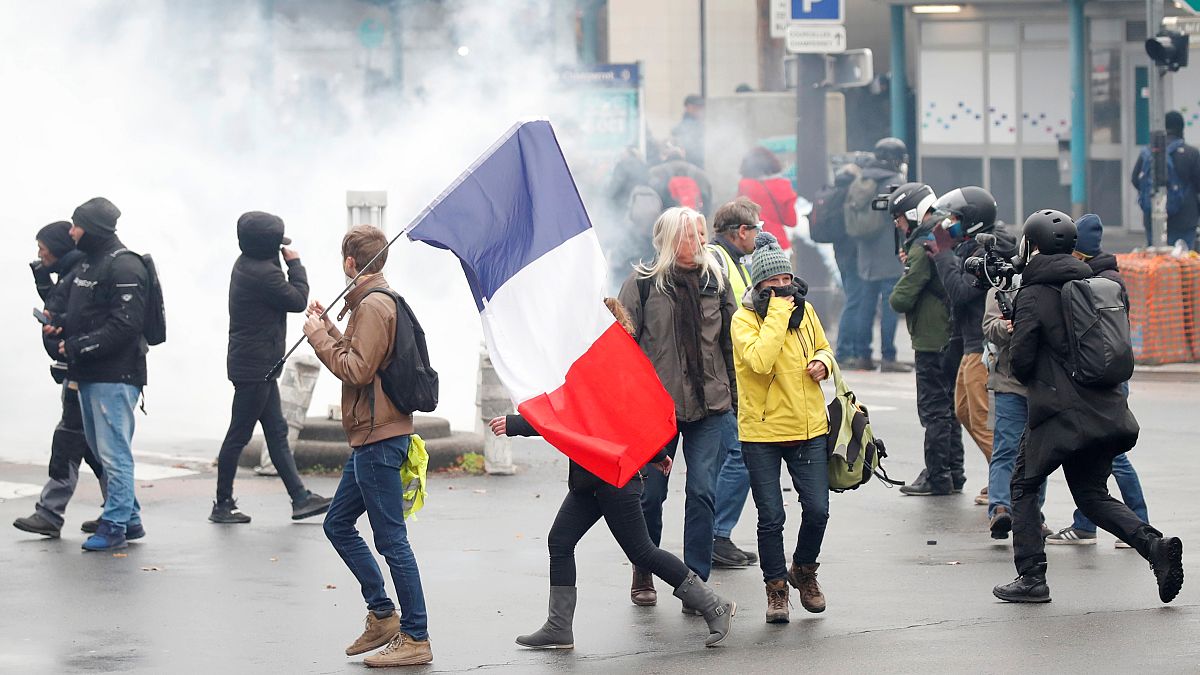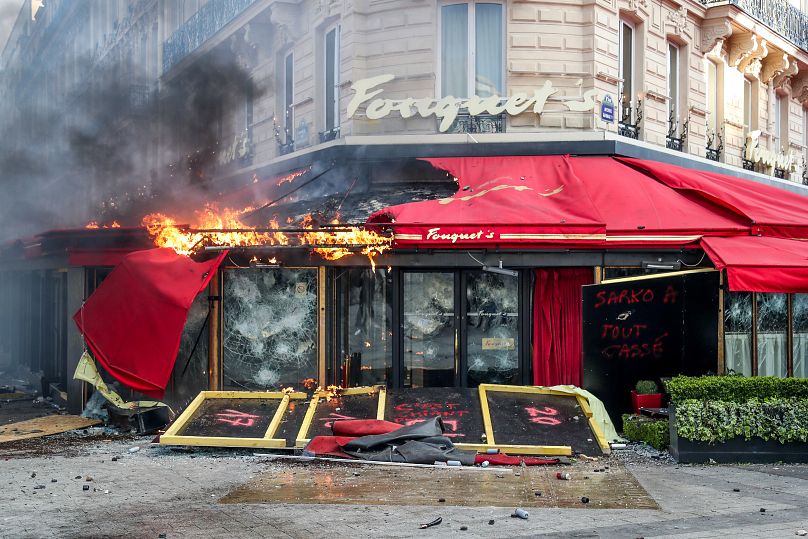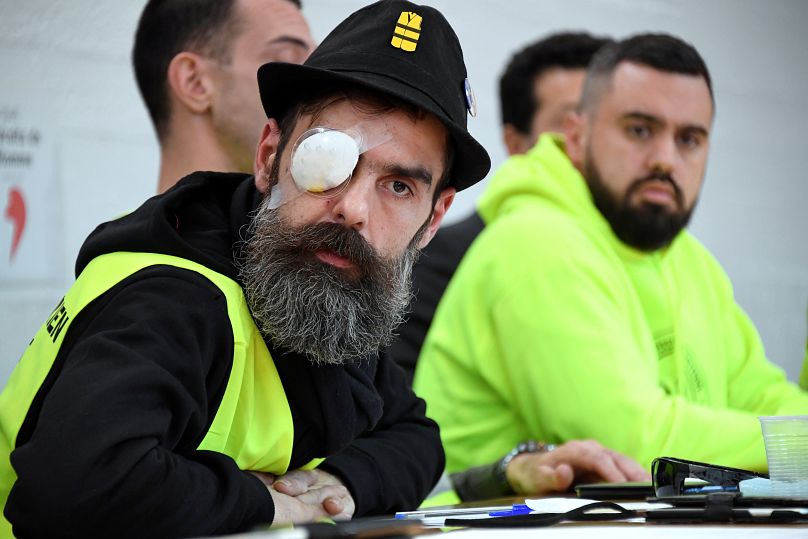“It would just take one mistake from the government for the fire to resume," says Jerome Rodrigues, who said he lost his sight in one eye in clashes with police.
It was a year ago this weekend that hundreds of thousands of protesters angry about a new fuel tax took to the streets across France. To illustrate their anger, they wore the yellow high-visibility jackets that motorists are required to carry in their cars in case they are involved in an accident.
Since then, the so-called `"yellow vests" ("gilets jaunes") movement has snowballed into a wider anti-government platform, bringing together individuals from across the political divide but united by a shared opposition to the policies of the French government under President Emmanuel Macron.
The numbers have certainly dwindled over the past 12 months, but the Gilets Jaunes have made their presence felt in many of France's largest cities every weekend since the beginning of the movement.
As the movement marks its first anniversary with fresh protests — including clashes in northwest Paris that saw tear gas fired — Euronews looks at its origins, evolution, and prospects for the future.
How did it begin?
More than 280,000 people wearing yellow jackets took to the streets across the country on 17 November 2018, after a call was put out on Facebook.
The protesters were not affiliated with any political party or trade union, and had no designated leader.
But the protests were there to stay. Every Saturday, mass demonstrations against the government were held in major French cities, and citizens occupied roundabouts all week round.
Initially peaceful, many protests took a violent turn.
In Paris, it was common for tear gas to hang in the air on Saturdays as protesters clashed with police, whose heavy-handed response often drew condemnation from rights groups.
At the same time, violent elements in the movement smashed shops, defaced monuments and set cars ablaze in some of the worst rioting seen in Paris in decades.
Although the protests were initially against the fuel tax, they quickly spiralled into broader protests against social inequality, the high cost of living and Macron’s pro-business policies.
Jerome Rodrigues, a prominent figure of the movement, told Euronews that what drove people to the streets was simple.
“All that people want is to be able to live from their salaries,” Rodrigues said.
“Just having enough to eat until the end of the month and being able to take the kids to the movies once in a while."
Other aims included a demand for greater representative democracy in France, including a so-called référendum d’initiative citoyenne, or citizen initiatives to launch referendums.
How did the government respond?
The scrapping of the fuel tax in December 2018 was not enough to quell the protests, so the following January Macron launched the so-called "Great National Debate", touring the country in an attempt to break the elitist, out-of-touch image that many citizens have of politicians.
Six months down the line, the public consultations produced €17 billion worth of tax cuts and other fiscal incentives.
Eric Bothorel, an MP from Macron’s party La République en Marche (LREM), told Euronews the "yellow vests" movement had “completely shaken up the parliamentary agenda” of the past year.
The National Assembly held sessions in December in the run-up to Christmas to pass the first measures announced by the head of state, he said, all while preparing for the Great National Debate.
He cited tax exemptions for retirement pensions and a rise in benefits for disabled people among the key measures taken in response to the protests.
What has the movement achieved?
Many "yellow vest" protesters remain unconvinced by the government’s concessions.
Rodrigues told Euronews that the results one year on were "meagre" when it comes to achieving the demands of the protesters, with the exception of the so-called 'tax free premium", paid by companies to employees at the end of the year.
Christian Le Bart, a political scientist at Sciences Po Rennes, agreed. While the "yellow vests" obtained “small” concessions from the government, he said, they “didn’t turn the tables".
But Bothorel, unsurprisingly, doesn't agree.
“Of course, there will always be people to say that it is not enough, that it’s hard to live with the minimum wage. I can’t say anything. It’s true,” Bothorel said, adding: “We’re working on it."
A major gripe of the Gilets Jaune is the actions of police, said Rodrigues, recalling how he lost vision in his eye after he claimed he was attacked by security forces last January.
He is not alone. A total of 24 protesters lost an eye following the use of so-called defensive bullets launcher (LBD) shots, AFP reported.
According to authorities, about 2,500 demonstrators and 1,800 security forces were injured, while 11 people have died, mostly in road accidents. The French authorities argue that no protesters have been killed as a result of police action.
The movement has also failed to turn its presence on the streets into political representation. Although there were candidates affiliated with the yellow vests at the last European elections in May, they won well below 1% of votes.
The prospects do not look any better at the French local elections in March, Le Bart added.
On a more positive note, Rodrigues said, the movement played an important role in highlighting social justice and excessive taxation.
It also allowed citizens to get together and discuss solutions to problems, helping recreate “a fraternity that was lost,” he said.
Meanwhile, the achievements of the yellow vests movement may come into a better light in the medium term, Le Bart said.
“Clearly, there is a before and an `after yellow vests in the public debate,” Le Bart said, calling the movement “democracy of the roundabouts”.
Le Bart added that the yellow vests shed light on social groups that usually consider themselves as invisible - “a France that has difficulties at the end of the month, a France of precarity, which limits its own consumption - quite discrete but yet numerically very important".
Bothorel agreed that the movement profoundly changed the way politics is done by further integrating citizens into policy-making.
As an example, he said, the government was setting up citizens assemblies whose members are determined through a random draw.
Is it the end of the yellow vests?
From over 280,000 protesters at the height of the movement a year ago, turnout dropped below 6,000 in late June, according to France's interior ministry (see graph below).
After this date, the turnout was so low - merely a few hundred people - that the authorities stopped counting.
A year on, roundabouts across the country functioning normally again, the campfires have gone out and many protesters have packed away their brightly coloured jackets.
Rodrigues told Euronews that fewer people were protesting every weekend not because they had lost interest in the movement, but because of police repression.
Meanwhile, a survey by pollster Odoxa published two weeks ago showed nearly one in every two French people believed the movement might re-emerge.
Authorities fear that yellow vests could band together with other disgruntled groups such as transport and health workers or students, leading to another winter of discontent.
READ MORE: French students protest over poverty after attempted suicide
Earlier this week, students demonstrated across France to protest over precarity and living conditions and show solidarity with a destitute young man who set himself on fire.
On Thursday, thousands of hospital workers took to the streets to protest years of cutbacks.
And railway workers are planning mass strike action in December over pension reforms.
READ MORE: Thousands of French hospital workers protest years of cutbacks across the country
“The embers remain," said Rodrigues, "the flames are not so vivid anymore but the embers are here for good.
“It would just take one mistake from the government for the fire to resume.”


